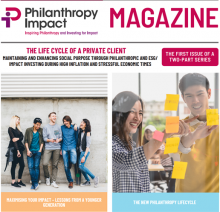The Compounding Effects of Good Advice – Philanthropy Impact Magazine article (December 2022)
The quality of advice a client might receive from their tax advisor or wealth manager used to be measured by the initials after an advisor’s name and the tasteful thickness of their business card. However, when it comes to specialisms, neither experience nor expertise are the superpower they might sound like.
Instead, they can be handcuffs to perspective; “that’s the way we have always done it” can be a totem pole of sub-standard outcomes. Too often advisors arrive with prepared answers or an expectation that issues will be resolved if they try enough standard techniques in the guise of best practices. However. what is appropriate for one client is often completely wrong for another. Advisors get trained to disseminate information when they should be trained to listen.
The illusion of control might increase confidence, but not accuracy, worsening the outcome as clients progressed from wealth creation strategies to wealth preservation strategies and then on to wealth utilisation strategies.
Many advisors don’t want to initiate a discussion on philanthropy with their clients as they understandably would rather give no advice than bad advice. They avoid focusing on human capital as you can’t get a qualification in emotional intelligence. However, we can become better advisors by getting comfortable with dealing with the uncomfortable. We need to acknowledge luck’s role in our success and risk’s role in our failures.
The problem with the traditional world of ‘maximised tax efficiency’ and ‘optimised investment strategies’ is that a plan is only useful if it can survive reality. Yet reality is full of unknowns, so it is important to have a margin for error, a margin of safety. The more specific points of your plan you need to be true, the more fragile your plan really is. The transfer of wealth and assets is as much about relationship management as it is about technical advice. For all the appropriate tax planning and sophisticated structures, if clients and their advisors haven’t worked on the non-financial aspects then clients are likely to fail to achieve their intended aims.
Conversations around giving can be a learning experience on both sides, they can help close the information gap between advisors and their clients. It is not uncommon for new clients to initially tell advisors what they think the advisors wants to hear. Larger families might want to copy structures and approach of families they know without thinking if it suits their family.
Philanthropic advice is not about imposing values but unearthing them. These discussions should not be about encouraging giving rather about helping clients understanding the journey of their wealth; if it is all to pass on to the next generation how does the current generation want them to engage and utilise it?
It is still a taboo in many families to discuss inheritance during lifetime with the contents of wills only reveals to all parties on death. The ability of advisors to discuss the potential for philanthropic giving is not just about advising existing clients but also building a bridge of understanding with those that follow. It can support families in understanding how personal goals will change and how the intergenerational transfer of wealth brings new expectations and measures of success.
Family discussions on philanthropy can provide a relatively neutral space which can be uses as a form to help educate family members and can also be vehicle of inclusiveness by including more distant/non-blood relatives/in-laws in discussions on the family’s future. It can connect across generations to act as a bridge between grandparents and their grandchildren. For advisors if provides the ability to make sure all members of a family are heard.
Every family has internal conflict and disagreements, but many allow it fester rather than resolve. Advisors can be sherpas for some of the family baggage, but they cannot decide on the destination a family should take. Within the safety of conversations around supporting those outside the family, advisors can uncover historic resentments that colour the lenses of current behaviour. Philanthropic discussions are not just a feel-good/guilt-reduction exercise, they are a form of family cohesion work. Work done to prevent fragmentation, to ensure the continuity of family wellbeing.
Family philanthropy can also be a sandbox for future entrepreneurs and a training ground for education the next generation without revealing the totality of the family wealth. It can also help being a further meaning to success, many businesses owners can feel slightly lost after a liquidity event and its corresponding impact on their identity.
Understanding philanthropic options is not just about grand multi-generational plans. The 2022 Remember A Charity Consumer Benchmarking Study, found that only 19% of UK charity donors currently intended to make a charitable bequest in their will which suggest the number in the wider population is even lower despite the opportunity to reduce IHT charges. While a 2016 study by HMRC found that only 52% of UK Higher & Additional Rate taxpayers were aware of the 20-25% tax rebate component to Gift Aid.
While traditional private client advice was based on clients discussing “what” they are, the success of modern private client advice hinges on clients telling their advisors how they got to be “who” they are.
Our job is probabilistic, not one of certainty. While there might be a right and a wrong way of making small decisions, how they compound into a lifelong plan should be the aim of all private client advisors.







